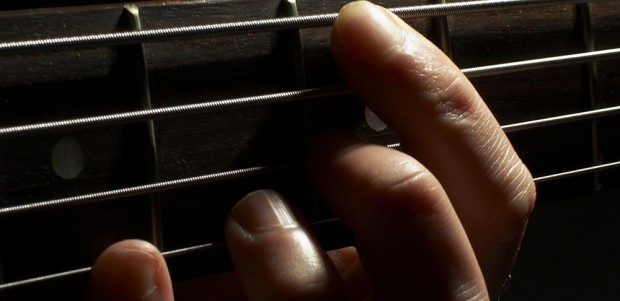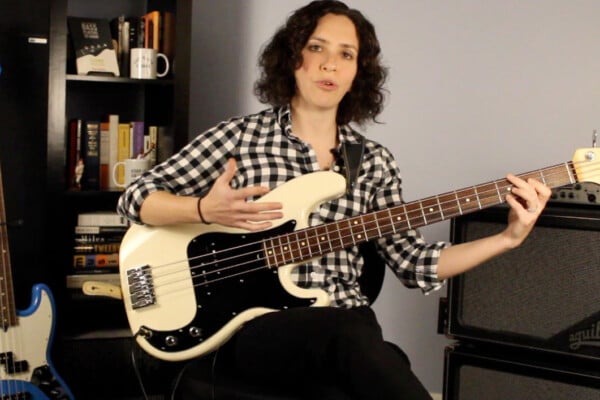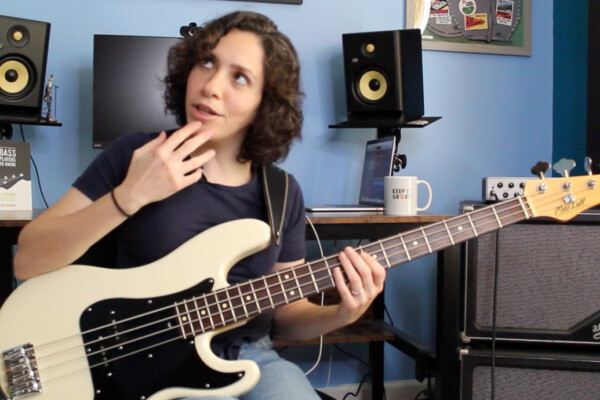How to Build Muscle Memory: A List for Bass Players

Q: I hear everybody talking about “muscle memory”, i.e. being able to play without looking at the fingerboard. How do you get there? Any special advice or exercises, especially for fretless?
A: Muscle memory is crucial to your development as a player. I also consider the ability to use harmonic devices (like substations and different chord scales) a type of muscle memory, but that’s a subject for another time.
Muscle memory really depends on only one thing: repetition! If you make a movement hundreds or thousands of times, your body will begin to require less and less feedback to make the movement successfully. By feedback I mean feeling the frets on your fretboard, or the feedback you get when you hit a note that’s sharp or flat of your target.
In short, there is not a whole lot to do beyond simply repeating exercises, licks and bass lines over and over again.
There are ways to push yourself, though. Here’s a list of recommendations:
Play blind. Turn off the lights in your practice room to eliminate your eyes from the equation. This means that there is no feedback beyond your touch and your ears.
Practice making intervallic leaps without looking. See if you can hit every “C” on your fretboard without looking. You can do this on a string by string basis (one string at a time, hitting an octave) or by position.
If you’re playing a fretless, you can play slowly through a tuner, without looking at the fretboard. Playing a simple scale slowly through a tuner can really help you dial in your intonation.
When you’re ready for the next step, try linear classical etudes and scaler exercises
Play against a drone. Whether it is on the fly melodies or scales, playing against a drone is a fantastic way to explore tonal relationships, pitch correction and harmonic tendencies.
Pay attention to your technique. Using good hand positions will go a long way towards your fingers aim on the fretboard. Are your hands bunched up or are spread out fairly well with a nice arc to the hand? Imagine holding a tennis ball in your hand. That is pretty much what your hand should look like most of the time.
I heard the great bassist Kai Eckhardt speak once about how his intonation really came together when he realized that variances in intonation were somewhat natural. Specifically, he re-oriented his perception. Instead of dreading that feeling when you realize that you are a bit flat or sharp, he tried to perceive the out-of-tune note which gently glides up or down to the proper intonation as akin to a vocal inflection. It’s expressive, not wrong, in essence. This seemed to transform his playing and actually served to make him more in tune, because he wasn’t worried about it in the same way that he was before. This allows him to react to the sound in a natural and expressive way. Granted, his intonation was already pretty darned good!
That is in no way an excuse to play out of tune. Ultimately, you must also be listening well and adjust your intonation to match the music around you. In fact, I’ve found that a perfectly in-tune note doesn’t always sound best. I’ve noticed on gigs that the music sometimes prefers that I play just a bit sharp. I don’t know if this has anything to do with the limitations of equal-tempered tuning, but I trust my ears. (Equal tempered tuning is not perfectly in tune as the frets lay on your fretboard. It’s a compromise to make most things mostly in tune. Before equal temperament, pianos had to be tuned specifically to the key they were going to be played in before a concert.)
How Equal Temperament Ruined Harmony (and why you should care) by Ross W. Duffin is a great book that might be of interest to you.
I must admit that 98% of the time I play fretted basses, so my experience in fretless intonation is limited. I use lines and look at my fretboard when I am playing fretless. On my fretted bass, however, my muscle memory serves me well and I know the fretboard well enough that I don’t really have to look anymore.
On last thing. After completing this column, I realized that I have written on the subject of muscle memory here before. Check out this column from 2011 for more thoughts.
I’m sure some of you have some fantastic tips! Please share your thoughts and list of tricks in the comments!
Have a question for Damian Erskine? Send it to [email protected]. Check out Damian’s instructional books, Right Hand Drive and The Improviser’s Path.




Well said and written! A lot to think about. Playing “occasional fretless” is always a challenge, but personally I found it easier to intonate on an unlined fingerboard, because I had to trust my ears instead of the eyes. Demands good monitoring, though. I’ve recently started playing the Chapman Stick, and try to play without watching. Not too hard avoiding taking a glance, since it demands an uncomfortable position of my neck/head just to have a glance at the lower positions. Also – it feels better not to take a peek…
Hey Damian, a great read as always; the link for the related-previous article however directs to this very page :)
I used to play in the dark a lot. I’d put on a Police or RUSH record and just pump away. Don’t sweat the mistakes because you’re going to be playing the same parts over and over for awhile so a mistake here and there is expected. If you weren’t making mistakes you wouldn’t need to do the exercises.
The best tip my instructor ever gave me was; “Don’t look at your fingers”. Youn people think I’m an idiot. They’ll figue it out the hard way.